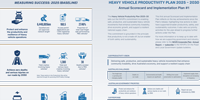Heavy Vehicle Productivity Plan (HVPP) 2025-2030 (PDF, 1.5MB)
This plan outlines how the NHVR aims to deliver safe, productive, and sustainable heavy vehicle movements that enhance community liveability, drive Australia’s economy, and support a resilient supply chain.
The plan does not cover our full work program; instead, it sets out 22 actions over a five-year period, based on priorities set by our stakeholders, so we can work together to tackle Australia’s freight challenges and support delivery of the following Australian Government priorities:
- Protect and enhance the productivity and resilience of heavy vehicle operations.
- Achieve zero deaths and serious injuries on our roads by 2050.
- Reach net zero emissions by 2050.
Annual implementation plans
The annual implementation plans intend to ensure the Heavy Vehicle Productivity Plan is flexible and adapts to the evolving freight environment and responsive to changing stakeholder needs. They provide additional detail on the focus for the year, how certain actions may be delivered and success measured, and a scorecard of achievements.
HVPP Year 1 Implementation Plan (2025) (PDF, 388KB)
This first annual implementation plan includes a scorecard outlining key achievements delivered in 2025, as well as the key areas of focus for delivery in 2026. It establishes baseline metrics for productivity and related safety and sustainability performance, enabling consistent longitudinal assessment of outcomes over time. Annual implementation plans will continue to report against this baseline while highlighting achievements and setting priority focus areas for the year ahead.

 Accessibility tools
Accessibility tools



